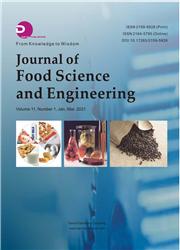Transfatty Acids (TFAs) in Cord Blood and Cord Tissue, in France
引用次数: 1
Abstract
Background: Recent studies suggest that dietary transfatty acids (TFAs) at relative high levels (i) increase the risk of coronary heart disease, (ii) inhibit the metabolism of linoleic acid and consequently increase requirement for essential fatty acids (EFAs). The aim of this prospective study was to estimate TFAs the placental transfer of TFAs to the foetus cord blood and cord tissues in France. Material: TFAs consumption was measured in 59 mother-foetus couples. TFAs transferring across the placenta were estimated by comparative measurement (Capillary Gaz Chromatography) of TFAs in mother’s blood lipids (n = 59), cord blood lipids and cord tissue plasma lipids (n = 25) cord red blood tissue (n = 25) and umbilical vessels (n = 15). Results-Discussion: TFA deposition in cord blood is 0.58% slightly lower than mother level. TFAs incorporation in total lips of cord show selectivity of transfer with lower 18:1 t in cord blood and preferential transfer of diene 18:2 tc in cord blood. There is competition between the 18:2 tc in cholesterol esters (CE) with the linolenic acid and a negative correlation in PLT of arterial tissues with the 18:2 tc and C20:4 n-6 or arachidonic acid (AA), then there is the same competition in PE of venous tissue. But there is no effect on growth in our population of term newborn. Conclusions: Our results confirm the placental TFAs transfer, a better incorporation in the fetus CE; we demonstrated a selective transfer for the 18:2 9 trans 12 cis (18:2 tc) and a negative correlation (r = -0.76) with the linoleic acid and AA (r = 0.98). This competition, and the presence of these TFAs in cord tissues, even at a low TFAs consumption, remind us to be a potential risk for the fetus concerning EFA metabolism and growth.法国脐带血和脐带组织中的转铁蛋白
背景:最近的研究表明,相对较高水平的膳食转基因脂肪酸(TFAs)(i)会增加患冠心病的风险,(ii)会抑制亚油酸的代谢,从而增加对必需脂肪酸(EFAs)的需求。这项前瞻性研究的目的是评估TFAs——TFAs在法国胎盘转移到胎儿脐带血和脐带组织的情况。材料:对59对母婴夫妇的全氟辛烷磺酸消耗量进行了测量。通过比较测量(毛细管气相色谱法)母亲血脂(n=59)、脐带血脂和脐带组织血脂(n=25)、脐带红组织(n=25,n=25)和脐带血管(n=15)中的TFAs来估计通过胎盘转移的TFAs。结果探讨:TFA在脐血中的沉积量为0.58%,略低于母体水平。TFAs在脐带总唇中的掺入显示出转移的选择性,脐带血中具有较低的18:1T,而二烯在脐带血中优先转移18:2Tc。胆固醇酯(CE)中的18:2 tc与亚麻酸存在竞争,动脉组织的PLT与18:2 tc和C20:4 n-6或花生四烯酸(AA)呈负相关,静脉组织的PE也存在同样的竞争。但这对我们足月新生儿的增长没有影响。结论:我们的结果证实了胎盘TFAs的转移,在胎儿CE中有更好的结合;我们证明了18:2 9反式12顺式(18:2 tc)的选择性转移,与亚油酸和AA呈负相关(r=-0.76)(r=0.98)。这种竞争,以及这些TFA在脐带组织中的存在,即使在低TFA消耗的情况下,也提醒我们胎儿在EFA代谢和生长方面存在潜在风险。
本文章由计算机程序翻译,如有差异,请以英文原文为准。
求助全文
约1分钟内获得全文
求助全文

 求助内容:
求助内容: 应助结果提醒方式:
应助结果提醒方式:


